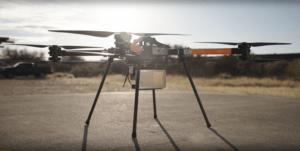 Honeywell Drone Mounted Radar Helps Drones Dodge Obstacles Mid-Air
Honeywell Drone Mounted Radar Helps Drones Dodge Obstacles Mid-Air
by DRONELIFE Staff Writer Ian M. Crosby
Honeywell’s IntuVue RDR-84K radar system, a part of Honeywell’s Beyond-Visual-Line-of-Sight suite of technologies, has successfully piloted a drone in a high-stakes game of dodgeball, continually avoiding intruder aircraft in a series of tests that are crucial to the future of autonomous aviation. These tests showcased the ability of the radar to not only detect airborne traffic but also decide autonomously on a course of action by taking over navigation and piloting the aircraft to safety using its onboard processor.
“We set up the ultimate game of ‘chicken,’ but the RDR-84K simply wouldn’t let these aircraft get into danger,” said Sapan Shah, product manager, Advanced Air Mobility, Honeywell Aerospace. “This is a leap forward in safety that could have far-ranging impacts across aviation.”
Avoiding unforeseen objects is an essential requirement for autonomous drones and other aircraft that fly beyond visual line of sight (BVLOS). However, this detect-and-avoid capability is extremely difficult in the air. Radars require long ranges due to the high speeds involved, and they must distinguish airborne traffic from activity on the ground. They also need precise location information to comprehend radar echoes. To compensate, pilots and air traffic control radars rely on cooperative aircraft to beam out their locations using onboard transponders. Objects without transponders are known as “noncooperating” traffic.
While the RDR-84K, weighing in at just under 2 pounds and the size of a paperback book, has previously demonstrated its ability to detect noncooperating traffic during extensive testing, the new tests marked the first time it has performed the avoidance function without human intervention.
Honeywell engineers flew two quadcopter drones, both on autopilot, directly towards each other. In multiple flights, the drone equipped with the RDR-84K detected the noncooperating “intruder” drone and examined its flight path before calculating an avoidance maneuver and taking over navigation — flying in a new direction or stopping midair, depending on winds and other factors. Once there was no longer danger of collision, the radar released control of the drone, and the autopilot guided it back to its original course.
“This was all automatic,” said Larry Surace, lead systems engineer for the RDR-84K, Honeywell Aerospace. “The radar recognized the danger, decided on a course of action, flew to safety and then made sure the danger had passed — all without input from anyone on the ground.”
The team then pitted the RDR-84K against increasingly difficult encounters, including approaching from below to blend into ground clutter and from offset angles, testing the radar’s peripheral vision and high angular detection capabilities. During some tests, the team instructed the radar to wait longer before acting, forcing it to make more aggressive maneuvers.
“The radar handled everything we threw at it,” said Surace. “It saw the danger immediately and successfully executed multiple avoidance maneuvers.”
The RDR-84K’s onboard processor calculates avoidance paths, removing the need for a separate computer to carry out this function. The radar is able to detect targets 3 kilometers away and utilizes monopulse technology — a system of overlapping beams — to increase accuracy and eliminate ground clutter. The radar steers its beams electronically, foregoing moving parts.
Asides from detecting traffic, the RDR-84K is also able to map terrain and provide alternate navigation in the case of GPS failure, as well as serve as a radar altimeter during landing.
Read more about Honeywell in the drone industry:
- Hydrogen Fuel Cells for Passenger Drones: Honeywell Purchases Ballard Unmanned Systems Assets
- Honeywell Partners with Intel on UAV Inspection Service
Read more about collision avoidance systems:
- NASA Tests Drone Collision-Avoidance Technology
- Zurich Researchers Teach Drone to Dodge with Dynamic Obstacle Avoidance
- Iris Automation Inks Drone Safety Agreement with Transport Canada
 Ian attended Dominican University of California, where he received a BA in English in 2019. With a lifelong passion for writing and storytelling and a keen interest in technology, he is now contributing to DroneLife as a staff writer.
Ian attended Dominican University of California, where he received a BA in English in 2019. With a lifelong passion for writing and storytelling and a keen interest in technology, he is now contributing to DroneLife as a staff writer.

Miriam McNabb is the Editor-in-Chief of DRONELIFE and CEO of JobForDrones, a professional drone services marketplace, and a fascinated observer of the emerging drone industry and the regulatory environment for drones. Miriam has penned over 3,000 articles focused on the commercial drone space and is an international speaker and recognized figure in the industry. Miriam has a degree from the University of Chicago and over 20 years of experience in high tech sales and marketing for new technologies.
For drone industry consulting or writing, Email Miriam.
TWITTER:@spaldingbarker
Subscribe to DroneLife here.







[…] post Honeywell Drone-Mounted Radar: Helping Unmanned Systems Avoid Mid-Air Collisions appeared first on […]